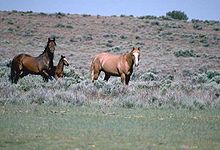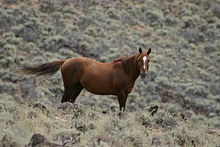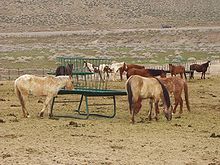- Mustang horse
-
This article is about the horse. For other uses, see Mustang (disambiguation).
Mustang 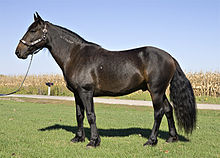
Mustang adopted from the BLMDistinguishing features Small, compact, good bone, very hardy Country of origin North America Horse (Equus ferus caballus) A Mustang is a free-roaming horse of the North American west that first descended from horses brought to the Americas by the Spanish. Mustangs are often referred to as wild horses, but there is intense debate over terminology. Because they are descended from once-domesticated horses, they can be classified as feral horses.
In 1971, the United States Congress recognized Mustangs as “living symbols of the historic and pioneer spirit of the West, which continue to contribute to the diversity of life forms within the Nation and enrich the lives of the American people.” Today, Mustang herds vary in the degree to which they can be traced to original Iberian horses. Some contain a greater genetic mixture of ranch stock and more recent breed releases, while others are relatively unchanged from the original Iberian stock, most strongly represented in the most isolated populations.
Today, the Mustang population is managed and protected by the Bureau of Land Management. Controversy surrounds the sharing of land and resources by the free ranging Mustangs with the livestock of the ranching industry, and also with the methods with which the federal government manages the wild population numbers. An additional debate centers on the question if Mustangs—and horses in general—are a native species or an introduced, invasive species. Many methods of population management are used, including the adoption by private individuals of horses taken from the range.
Contents
Etymology and usage
Mustangs are often referred to as wild horses but, since all free-roaming horses now in the Americas descended from horses that were once domesticated, the more correct term is feral horses.[1]
The English word "mustang" comes from the Mexican Spanish word mestengo, derived from Spanish mesteño, meaning "stray livestock animal".[2] The Spanish word in turn may possibly originate from the Latin expression animalia mixta (mixed beasts), referring to beasts of uncertain ownership, which were distributed in shepherd councils, known as mestas in medieval Spain.[3] A mestengo was any animal distributed in those councils, and by extension any feral animal.
History
Today, the only true wild horse is the Przewalski's Horse, native to Mongolia. However, the horse family Equidae and the genus Equus evolved in North America. Studies using ancient DNA as well as DNA of recent individuals shows there once were two closely related horse species in North America, the "wild horse" (Equus ferus) and the "Stilt-legged Horse;" which is taxonomically assigned to various names.[4][5] Thus, primitive horses lived in North America in prehistoric times. However, the genus Equus in North America died out at the end of the last ice age around 10-12,000 years ago, possibly due to a changing climate or the impact of newly arrived human hunters.[6] Thus at the beginning of the Columbian Exchange, there were no equids in the Americas at all. Horses first returned with the conquistadors, beginning with Columbus, who imported horses from Spain to the West Indies on his second voyage in 1493.[7] Domesticated horses came to the mainland with the arrival of Cortés in 1519.[8]
The first Mustangs descended from Iberian horses[9] brought to Mexico and Florida. Most of these horses were of Andalusian, Arabian and Barb ancestry. Some of these horses escaped or were captured by Native Americans, and rapidly spread throughout western North America.
Native Americans quickly adopted the horse as a primary means of transportation. Horses replaced the dog as a travois puller and greatly improved success in battles, trade, and hunts, particularly bison hunts.[10]
Starting in the colonial era and continuing with the westward expansion of the 1800s, horses belonging to explorers, traders and settlers that escaped or were purposely released joined the gene pool of Spanish-descended herds. It was also common practice for western ranchers to release their horses to locate forage for themselves in the winter and then recapture them, as well as any additional Mustangs, in the spring. Some ranchers also attempted to "improve" wild herds by shooting the dominant stallions and replacing them with pedigreed animals.
By 1900 North America had an estimated two million free-roaming horses.[9] Since 1900, the Mustang population has been reduced drastically. Mustangs were viewed as a resource that could be captured and used or sold (especially for military use) or slaughtered for food, especially pet food. The controversial practice of mustanging was dramatized in the John Huston film The Misfits, and the abuses linked to certain capture methods, including hunting from airplanes and poisoning, led to the first federal wild free-roaming horse protection law in 1959.[11] This statute, known as the "Wild Horse Annie Act," prohibited the use of motor vehicles for hunting wild horses and burros.[12] Protection was increased further by the Wild and Free-Roaming Horses and Burros Act of 1971.[13]
The 1971 Act provided for protection of certain previously established herds of horses and burros. Today, the Bureau of Land Management is the primary authority that oversees the protection and management of Mustang herds on public lands,[14] while the United States Forest Service administers additional wild horse or burro territories.[15]
Ancestry
Native American people readily integrated use of the horse into their cultures. Among the most capable horse-breeding native tribes of North America were the Comanche, the Shoshoni, and the Nez Perce. The last in particular became master horse breeders, and developed one of the first distinctly American breeds: the Appaloosa. Most other tribes did not practice extensive amounts of selective breeding, though they sought out desirable horses through acquisition and quickly weeded out those with undesirable traits.[citation needed]
In some modern mustang herds there is clear evidence of other domesticated horse breeds having become intermixed with feral herds. Some herds show the signs of the introduction of Thoroughbred or other light racehorse-types into herds, a process that also led in part to the creation of the American Quarter Horse.[citation needed] Other herds show signs of the intermixing of heavy draft horse breeds turned loose in an attempt to create work horses. Other, more isolated herds, retain a strong influence of original Spanish stock.
Some breeders of domestic horses consider the Mustang herds of the west to be inbred and of inferior quality.[citation needed] However, supporters of the Mustang argue that the animals are merely small due to their harsh living conditions and that natural selection has eliminated many traits that lead to weakness or inferiority. Some mustang supporters also maintain that some "inbreeding" actually concentrates the traits of hardiness and durability, making the mustang a valuable genetic resource.[citation needed] Regardless of these debates, the Mustang of the modern west has several different breeding populations today which are genetically isolated from one another and thus have distinct traits traceable to particular herds. These herds vary in the degree to which they can be traced to original Iberian horses. Some contain a greater genetic mixture of ranch stock and more recent breed releases, others are relatively unchanged from the original Iberian stock.[citation needed]
Two researchers have advanced an argument that Mustangs should be legally classified as "wild" rather than "feral." They argue that, due to the presence of Equus ferus ferus on the North American continent till the end of the Pleistocene era, horses were once native animals and should still be considered as native animals, and therefore defined as "wild,"[16] and not viewed as an exotic species that draws resources and attention away from true native species.[17]
Mustangs today
 Nevada's State Quarter, featuring the Mustang
Nevada's State Quarter, featuring the Mustang
Today, free-roaming horses are protected under United States law, but have disappeared from several states where there were once established populations.[18] A few hundred free-roaming horses survive in Alberta and British Columbia. The BLM considers roughly 26,000 individuals a manageable number,[19] but the feral Mustang population in February 2010 was 33,700 horses and 4,700 burros.[19] More than half of all Mustangs in North America are found in Nevada (which features the horses on its State Quarter in commemoration of this), with other significant populations in Montana, Wyoming and Oregon.[18] Another 34,000 horses are in holding facilities.[19]
Land use controversies
Controversy surrounds the presence of feral Mustang herds. Supporters argue that Mustangs are part of the natural heritage of the American West, whose history predates modern land use practices, and thus the animals have an inherent right of inhabitation.[20] However, other people remain vehemently opposed to their presence, arguing that the animals degrade rangeland and compete with livestock and wild species for forage.[21]
The debate as to what degree Mustangs and cattle compete for forage is multifaceted. One group of opponents, primarily cattle and sheep ranchers and those who depend on the livestock industry, argue essentially that feral horses degrade rangeland and compete with private livestock for public land forage.[22] The environmentalist community is split over the position of the Mustang within the North American ecosystem. This debate centers on the potential classification of Mustangs as either an introduced species such as cattle, or as a reintroduced native species due to the prehistoric presence of horses in North America, albeit with a gap of thousands of years between their extinction and reintroduction from European stock.[23]
Researchers note that most current Mustang herds live in arid areas which cattle cannot fully utilize due to the lack of water sources. Horses are better adapted by evolution to such climates;[24] they may range nine times as far from water sources as cattle, traveling as much as 50 miles a day.[25] This allows them to utilize areas not grazed by cattle. In addition, horses are "hindgut fermenters," meaning that they digest nutrients by means of the cecum rather than by a multi-chambered stomach. In practical effect, horses can obtain adequate nutrition from poorer forage than can cattle, surviving in areas where cattle will starve.[25]
Management and adoption
The Bureau of Land Management (BLM) is tasked with protecting, managing, and controlling wild horses and burros under the authority of the 1971 Wild Free-Roaming Horses and Burros Act to ensure that healthy herds thrive on healthy rangelands and as multiple-use mission under the 1976 Federal Land Policy and Management Act. Under the 1971 Act, shooting or poisoning Mustangs in the wild is illegal, and doing so can be prosecuted as a criminal felony.
Healthy adult Mustangs have few natural predators aside from mountain lions,[26] and to a lesser extent, grizzly bears and wolves.[27] The mountain lion is well known for predation on feral horses, and the larger members of the species may hunt both horses and moose. They are very effective predators that kill by either leaping onto an animal or chasing it down in a sprint, then grabbing the prey with their front claws and biting the neck, either at the windpipe or the spine.[28]
Where there is natural balance of predators and prey, Mustang numbers tend to stay in balance. However, in many areas, natural predators have been eliminated from the ecosystem.[27] Without some form of population control, Mustang herd sizes can multiply rapidly, doubling as fast as every four years.[12] To maintain population balance, (or, some argue, to make room for cattle[29]) one of the BLM’s key responsibilities under the 1971 law is to determine an appropriate management level (AML) of wild horses and burros in areas of public rangelands dedicated specifically for them.
Control of the population to within AML is achieved through a capture program. There are strict guidelines for techniques used to round up Mustangs. One method uses a tamed horse, called a "Judas horse," which has been trained to lead wild horses into a pen or corral. Once the Mustangs are herded into an area near the holding pen, the Judas horse is released. Its job is then to move to the head of the herd and lead them into a confined area.[30]
Most horses that are captured are offered for adoption to individuals or groups willing and able to provide humane, long-term care after payment of an adoption fee of at least $125.[31] In order to prevent the later sale of mustangs as horse meat, adopted mustangs are still protected under the Act, and cannot be sold in the first year except when certain very specific criteria are met. As of 2010, nearly 225,000 Mustangs have been adopted.[19]
Because there is a much larger pool of captured horses than of prospective adoptive owners, a number of efforts have been made to reduce the number of horses in holding facilities. At present, there are about 34,000 Mustangs in holding facilities and long-term grassland pastures.[19] The BLM has publicly considered euthanasia as a possible solution to overpopulation.[32] In January 2005, a controversial amendment was attached to an appropriation bill before the United States Congress by former Senator Conrad Burns, dubbed the "Burns rider."[33] This modified the adoption program to allow the sale (with the result usually being slaughter) of captured horses that are "more than 10 years of age", or that were "offered unsuccessfully for adoption at least three times."[34] In 2009, Secretary of the Interior Ken Salazar proposed the creation of federal wild horse preserves in the midwest, where non-reproducing animals would be kept.[35] Another approach to placing excess animals has been advanced by Madeleine Pickens, wife of oil magnate T. Boone Pickens, who seeks to create a private sanctuary in northern Nevada.[35] There are also increased efforts to assist with finding appropriate adoption homes. One example is a promotional competition, The Extreme Mustang Makeover, that gives trainers 100 days to gentle and train 100 mustangs, which are then adopted through an auction.[36]
See also
- Colonial Spanish Horse
- Feral horse
- Kiger Mustang
- Kleppe v. New Mexico
- Spanish Mustang
- Wild horse, including
Notes
- ^ The American Museum of Natural History The Nature of Horses
- ^ "Mustang". http://www.etymonline.com/index.php?term=mustang. Retrieved 2009-03-31.
- ^ Websters Third International Dictionary Unabridged
- ^ Weinstock, J.; et al. (2005). "Evolution, systematics, and phylogeography of Pleistocene horses in the New World: a molecular perspective". PLoS Biology 3 (8): e241. doi:10.1371/journal.pbio.0030241. PMC 1159165. PMID 15974804. http://biology.plosjournals.org/perlserv/?request=get-document&doi=10.1371%2Fjournal.pbio.0030241&ct=1. Retrieved 2008-12-19.
- ^ Orlando, L.; et al. (2008). "Ancient DNA Clarifies the Evolutionary History of American Late Pleistocene Equids". Journal of Molecular Evolution 66 (5): 533–538. doi:10.1007/s00239-008-9100-x. PMID 18398561.
- ^ "Ice Age Horses May Have Been Killed Off by Humans" National Geographic News, May 1, 2006.
- ^ Bennett, Deb. Conquerors: The Roots of New World Horsemanship.Amigo Publications, 1998, pp. 150 ISBN 0-9658533-0-6
- ^ Henry, Marguerite and Wesley Dennis. All About Horses. Random House, 1962. ASIN: B000MAJIB0
- ^ a b Dobie, The Mustangs
- ^ "Seeds of Change.", Corpus Christi Museum, Science and History educational resources. Accessed June 1, 2007.
- ^ "Wild Horse Annie Act". Wildhorsepreservation.com. http://www.wildhorsepreservation.com/resources/annie_act.html. Retrieved 2010-08-09.
- ^ a b Mangum, "The Mustang Dilemma," p. 77
- ^ "Background Information on HR297" (PDF). http://www.house.gov/apps/list/press/ii00_democrats/rahallwhbbkd.pdf. Retrieved 2010-08-09.
- ^ Mangum, "The Mustang Dilemma," p. 75
- ^ "Wild Horse and Burro Territories". http://www.fs.fed.us/rangelands/ecology/wildhorseburro/territories/index.shtml. Retrieved 2009-01-29.
- ^ "The Surprising History of America's Wild Horses". Livescience.com. 2008-07-24. http://www.livescience.com/animals/080724-nhm-wild-horses.html. Retrieved 2010-08-09.
- ^ "Wild Horses". Ngm.nationalgeographic.com. http://ngm.nationalgeographic.com/2009/02/wild-horses/fuller-text/5. Retrieved 2010-08-09.
- ^ a b "National Summary, FY2007" (PDF). http://www.wildhorsepreservation.com/pdf/National.pdf. Retrieved 2010-08-09.
- ^ a b c d e Mangum, "The Mustang Dilemma", p.77
- ^ http://www.wildhorsepreservation.org The American Wild Horse Preservation Campaign
- ^ see, e.g. National Academy of Sciences Report, 1982
General Accounting Office Report, 1991 - ^ "Bellisle, Martha. "Legislative battle brews over Nevada's wild horses" ''Associated press'' reprinted at I.G.H.A. / HorseAid's Bureau of Land Management News. Web site accessed May 11, 2007". Igha.org. http://www.igha.org/BLM8.html. Retrieved 2010-08-09.
- ^ "Wild Horses as Native North American Wildlife" Jay F. Kirkpatrick, Ph.D. and Patricia M. Fazio
- ^ "Wild Horses and the Ecosystem". Wildhorsepreservation.com. http://www.wildhorsepreservation.com/resources/ecosystem.html. Retrieved 2010-08-09.
- ^ a b Budiansky, Stephen. The Nature of Horses. Free Press, 1997. ISBN 0-684-82768-9
- ^ John W. Turner, Jr. and Michael L. Morrison (2008). "Influence of Predation by Mountain Lions on Numbers and Survivorship of a Feral Horse Population". The Southwestern Naturalist Vol. 46, No.2 pp. 183-190. http://wf2dnvr2.webfeat.org/. Retrieved 2008-08-29.
- ^ a b "FAQ'S On BLM Wild Horses" Wild Mustang Coalition. Web site accessed December 9, 2010
- ^ French, Brett. "Ferocious appetites: Study finds mountain lions may be eating more than previously believed." Billings Gazette. December 9, 2010. Accessed December 9, 2010.
- ^ "On BLM's wild horse management practices". Wildhorsepreservation.com. http://www.wildhorsepreservation.com/resources/study.html. Retrieved 2010-08-09.
- ^ French, Brett (September 3, 2009). "Controversial roundup of mustangs begins in Pryor Mountains". Billings Gazette. http://billingsgazette.com/news/state-and-regional/wyoming/article_aaad6ae6-98e2-11de-9717-001cc4c002e0.html. Retrieved 2011-02-04.
- ^ "How to Adopt a Wild Horse or Burro". U.S. Bureau of Land Management. http://www.blm.gov/wo/st/en/prog/wild_horse_and_burro/What_We_Do/wild_horse_and_burro0/how_to_adopt.html. Retrieved 2011-07-04.
- ^ ""Plan to kill wild horses runs into trouble" ''Associated Press,'' July 7, 2008" (PDF). http://www.letemrun.com/cnn.pdf. Retrieved 2010-08-09.
- ^ "The Story Behind the Burns Amendment". Wildhorsepreservation.com. http://www.wildhorsepreservation.com/resources/burns_story.html. Retrieved 2010-08-09.
- ^ "Burns amendment". Wildhorsepreservation.com. 2004-12-06. http://www.wildhorsepreservation.com/resources/burns_amend.html. Retrieved 2010-08-09.
- ^ a b Mangum, "The Mustang Dilemma", p.78
- ^ http://www.extrememustangmakeover.com The Extreme Mustang Makeover
References
- de Steiguer, J. Edward (2011). Wild Horses of the West: History and Politics of America's Mustangs (First ed.). Tucson: University of Arizona Press. p. 296. ISBN 978-0-8165-2826-4.
- Dobie, Frank (1952). The Mustangs (Seventh printing ed.). Boston: Little, Brown and Company. LC no. 52-6802.
- Mangum, A.J. (December 2010). "The Mustang Dilemma". Western Horseman: 70–80.
Further reading
- Nimmo, D. G., & Miller, K. K. (2007) Ecological and human dimensions of management of feral horses in Australia: A review. Wildlife Research, 34, 408-417
- Text of Wild Free-Roaming Horse and Burro Act of 1971
Equine Equine science and
management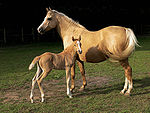
Equestrianism
and sportGlossary of equestrian terms · List of Equestrian Sports · Horse tack · Bit · Bridle · Saddle · Harness · English riding · Western riding · Driving · Horse training · Horse racing · Equestrian at the Summer Olympics (medalists, venues) · Horse show · EquitationEvolution and history Domestication · In warfare · In the Middle Ages · Horses in East Asian warfare · History of the horse in South Asia · Horses in the Napoleonic Wars · Horses in World War I · Horses in World War II · History of the horse in BritainHorse breeds, types
and other EquidaeList of horse breeds · Wild horse · Feral horse · Stock horse · Gaited horse · Draft horse · Warmblood · Sport horse · List of horse breeds in DAD-ISOther EquusHybridsCategories:- Horse breeds
- Feral horses
- Fauna of the Great Basin desert region
- Spanish loanwords
Wikimedia Foundation. 2010.

